Bottlenose dolphins have a gestation period of around 12 months and they generally wait around three years in between births. Dolphins don’t have a specific mating period, they are able to mate year round. The female dolphin cares for her newborn alone, without the help of the male. Female dolphins generally only have one newborn at a time and the baby is immediately taken to the surface for oxygen after giving birth. The newborn dolphin survives off the breastmilk of the mother for around 1 to 3 years.
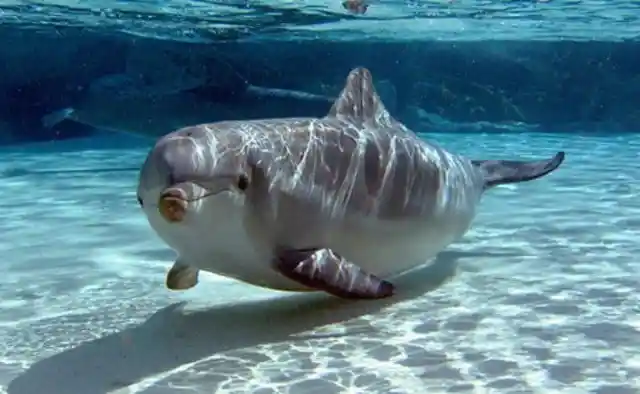
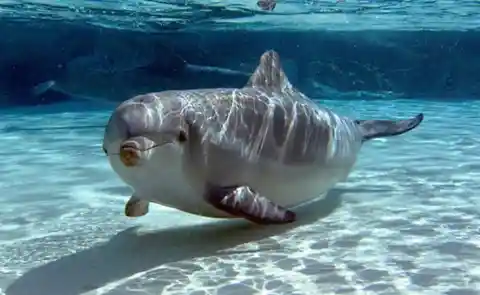
Bottlenose dolphins have a gestation period of around 12 months and they generally wait around three years in between births. Dolphins don’t have a specific mating period, they are able to mate year round. The female dolphin cares for her newborn alone, without the help of the male. Female dolphins generally only have one newborn at a time and the baby is immediately taken to the surface for oxygen after giving birth. The newborn dolphin survives off the breastmilk of the mother for around 1 to 3 years.
Everyone’s first sonogram is memorable, getting to see your baby for the very first time. In this picture, this ghost bat is having her very first sonogram. As not much is known about ghost bat pregnancies, the Sydney’s Featherdale Wildlife Park performed a sonogram. Interestingly enough, the ultrasound machine used is exactly the same as the one used when performing the procedure on humans. This little ghost bat gave birth about two months after this photo was taken and it turned out that the baby was perfectly healthy!
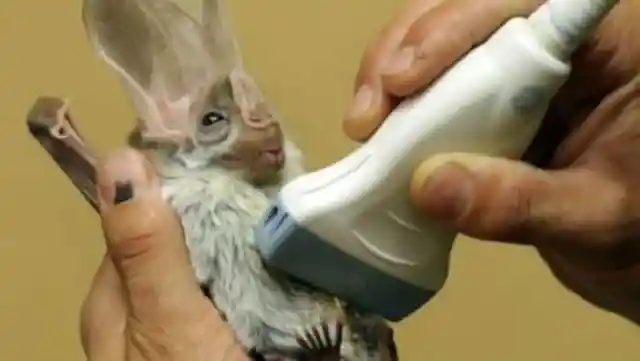
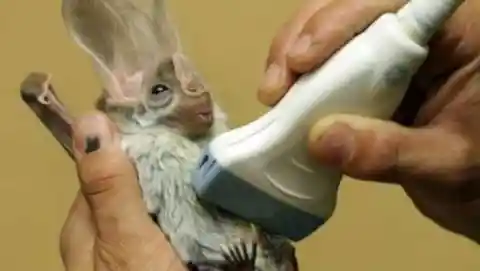
Everyone’s first sonogram is memorable, getting to see your baby for the very first time. In this picture, this ghost bat is having her very first sonogram. As not much is known about ghost bat pregnancies, the Sydney’s Featherdale Wildlife Park performed a sonogram. Interestingly enough, the ultrasound machine used is exactly the same as the one used when performing the procedure on humans. This little ghost bat gave birth about two months after this photo was taken and it turned out that the baby was perfectly healthy!
Just look at this mommy that looks like she ate a whole coconut! She's this round because her tummy can keep a litter of up to 8 pups. Just one female can have up to five litters in one year! Imagine how many little guinea pigs you'd have if you didn't separate the female pig from the male! It's very important to also know that female guinea pigs can start mating as early as two months, and will give birth to her pups after 59-73 days.
Just look at this mommy that looks like she ate a whole coconut!
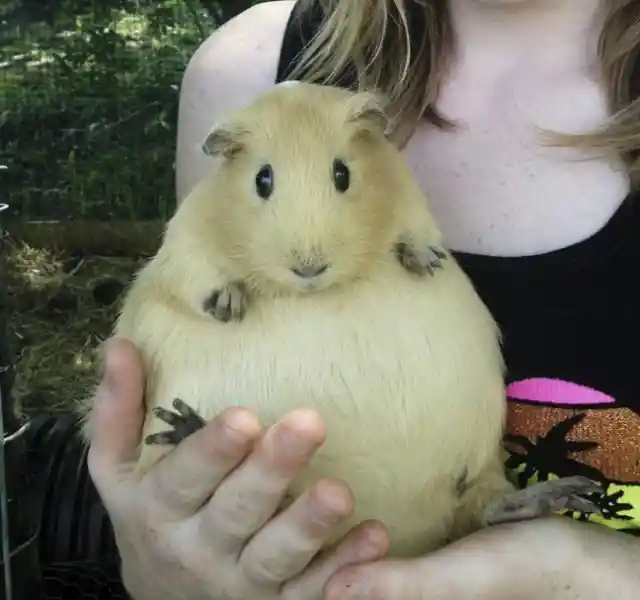
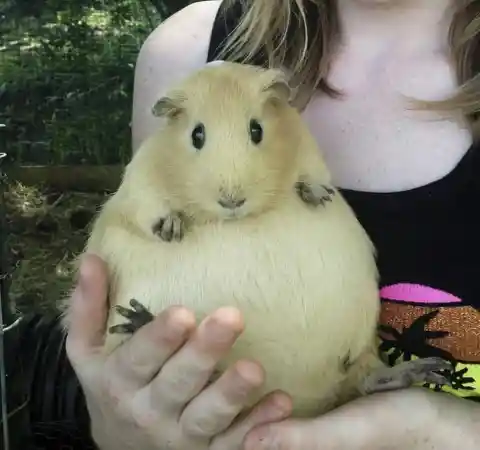
She's this round because her tummy can keep a litter of up to 8 pups. Just one female can have up to five litters in one year! Imagine how many little guinea pigs you'd have if you didn't separate the female pig from the male! It's very important to also know that female guinea pigs can start mating as early as two months, and will give birth to her pups after 59-73 days.
When you’re pregnant, being tired is a constant. This panda knows all about needing a little rest and relaxation. You might not be able to tell since pandas are so big, but she pregnant and apparently just wants to be left alone. The panda’s gestation period lasts for around 95 to 160 days and female pandas reproduce about one cub every two years. The cubs are born disproportionally small to the mother, at just 3.2 to 4.6 ounces. If you haven’t seen the hilariously adorable video of a baby panda sneezing, you’re missing out!


When you’re pregnant, being tired is a constant. This panda knows all about needing a little rest and relaxation. You might not be able to tell since pandas are so big, but she pregnant and apparently just wants to be left alone. The panda’s gestation period lasts for around 95 to 160 days and female pandas reproduce about one cub every two years. The cubs are born disproportionally small to the mother, at just 3.2 to 4.6 ounces. If you haven’t seen the hilariously adorable video of a baby panda sneezing, you’re missing out!
While women complain that doing stuff is difficult while pregnant, tell this to the poor giraffe who has to bend every day to drink water! A giraffe takes around 15 months to finally give birth to a calf, and when they are finally born, the calves drop from quite a distance. Adult giraffes are nearly six feet tall, and the mother will give birth while standing, the newborn will just have to hit the ground.
While women complain that doing stuff is difficult while pregnant, tell this to the poor giraffe who has to bend every day to drink water!
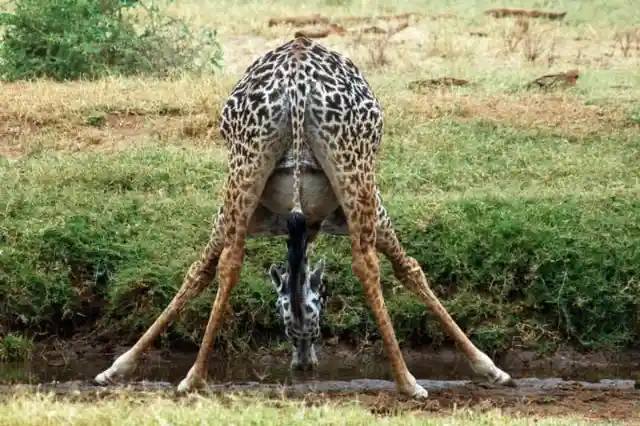
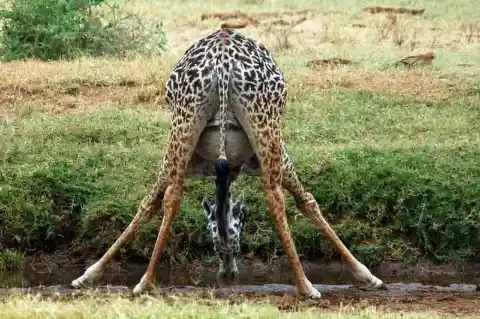
A giraffe takes around 15 months to finally give birth to a calf, and when they are finally born, the calves drop from quite a distance. Adult giraffes are nearly six feet tall, and the mother will give birth while standing, the newborn will just have to hit the ground.
The seahorse is known for its unique breeding habits. It’s one of the very few species in which the male carries the eggs after fertilization. The female deposits her eggs in the male’s pouch after a period of courtship, which can last several days. The seahorse can produce anywhere from 100-1,000 eggs at one time, however only .05% of the seahorse babies will survive. After their birth they are left on their own to survive, like most other fish. Scientists are still unsure as to why the male seahorse carries the eggs.
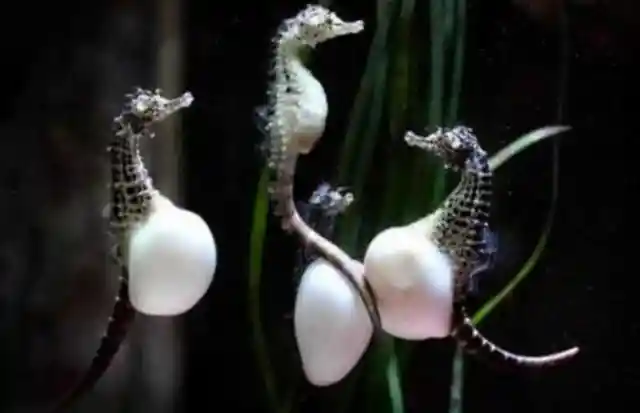
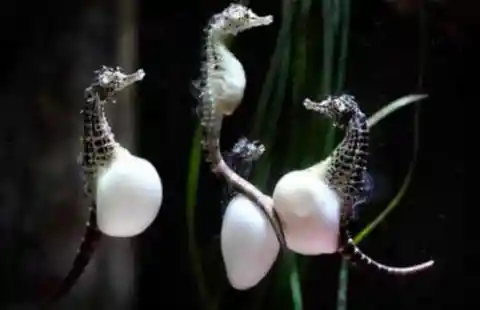
The seahorse is known for its unique breeding habits. It’s one of the very few species in which the male carries the eggs after fertilization. The female deposits her eggs in the male’s pouch after a period of courtship, which can last several days. The seahorse can produce anywhere from 100-1,000 eggs at one time, however only .05% of the seahorse babies will survive. After their birth they are left on their own to survive, like most other fish. Scientists are still unsure as to why the male seahorse carries the eggs.
This is how a pregnant or a very fat raccoon should look like. Considering the grass around it, we think it’s a pregnant raccoon, because they mate in late winter or early spring and two months later, close to the beginning of the summer, the raccoon mommies give birth to 1 up to 8 kits. The babies will stay in the den for nearly 3 months until their mom will take them out for some adventures in the wild!
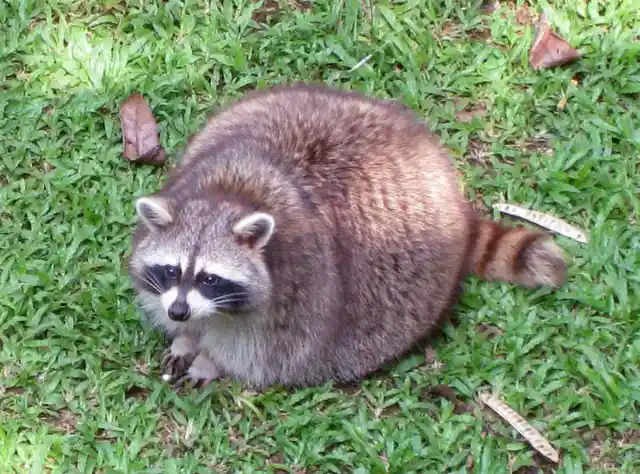
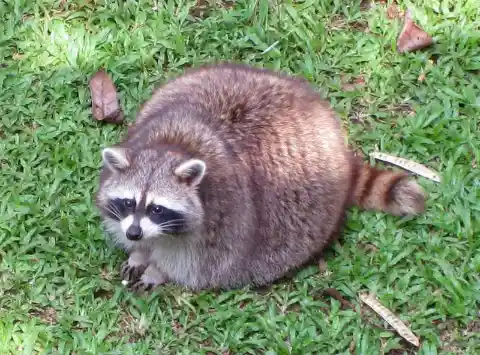
This is how a pregnant or a very fat raccoon should look like. Considering the grass around it, we think it’s a pregnant raccoon, because they mate in late winter or early spring and two months later, close to the beginning of the summer, the raccoon mommies give birth to 1 up to 8 kits. The babies will stay in the den for nearly 3 months until their mom will take them out for some adventures in the wild!
This is an x-ray of a female turtle prior to laying her eggs. Turtles come ashore to lay their eggs in a nest on a sandy beach a few weeks after mating. Almost all species of turtles nest during the warmest months of the year. The female turtle lays around 50 to 200 eggs in the nest and covers the nest with sand to keep the eggs moist, maintain temperature and to protect from predators. Most female turtles return to the exact same beach to nest year after year.
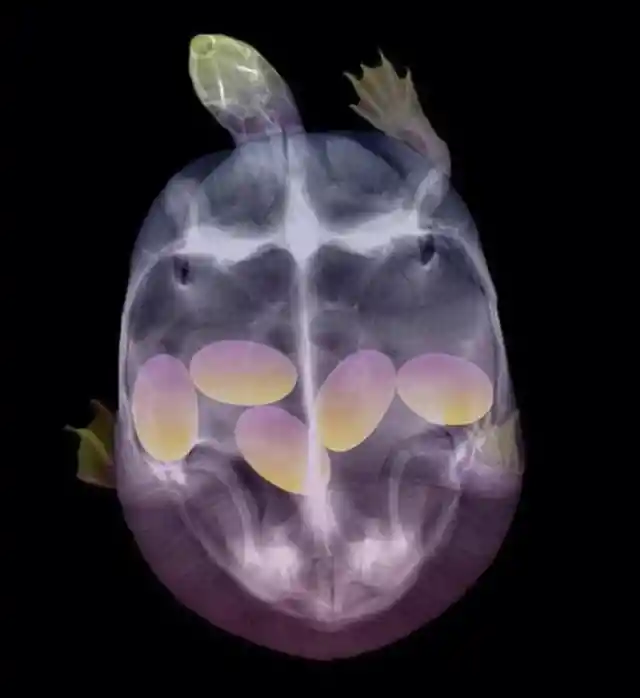
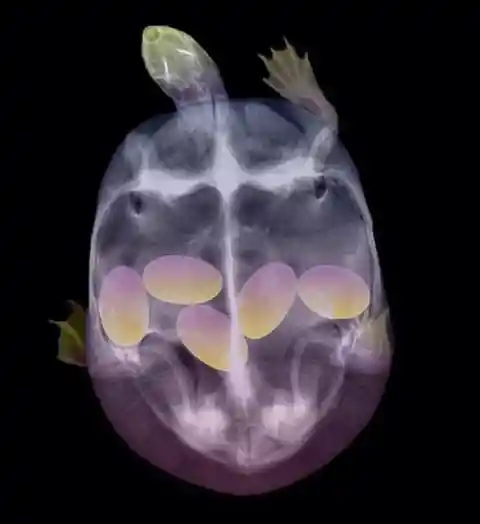
This is an x-ray of a female turtle prior to laying her eggs. Turtles come ashore to lay their eggs in a nest on a sandy beach a few weeks after mating. Almost all species of turtles nest during the warmest months of the year. The female turtle lays around 50 to 200 eggs in the nest and covers the nest with sand to keep the eggs moist, maintain temperature and to protect from predators. Most female turtles return to the exact same beach to nest year after year.
A baby joey is inside the koala’s pouch. It will take a long time for the little joey to be born. First, the gestation lasts 35 days, then the baby will crawl towards his mom’s pouch. The joey is born without any fur, years and blind. It will need to attack to his mom and feed in the pouch. As soon as the joey develops, it will start getting out of the pouch and ride his mom’s back. It will also go back to the pouch to drink some milk before he is weened and starts eating eucalyptus leaves.
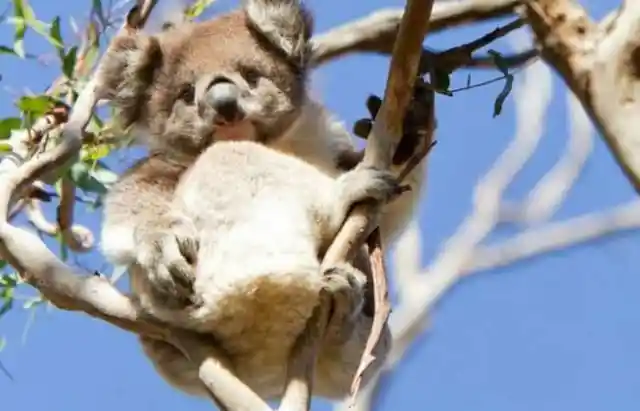
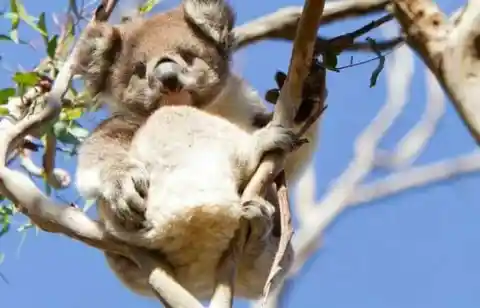
A baby joey is inside the koala’s pouch. It will take a long time for the little joey to be born. First, the gestation lasts 35 days, then the baby will crawl towards his mom’s pouch. The joey is born without any fur, years and blind. It will need to attack to his mom and feed in the pouch. As soon as the joey develops, it will start getting out of the pouch and ride his mom’s back. It will also go back to the pouch to drink some milk before he is weened and starts eating eucalyptus leaves.
This proud pregnant momma is the slowest moving mammal on the planet. Female sloths give birth to only one newborn at a time and stay with the baby for around five months after giving birth. The gestation period of a sloth is six months for three-toed sloths and six months for two-toed sloths. Interestingly enough, due to the anatomy of the sloth it can spend up to 90% of its life hanging upside down. Their internal organs are attached to their rib cage which means that hanging upside-down doesn’t put any pressure on their lungs.
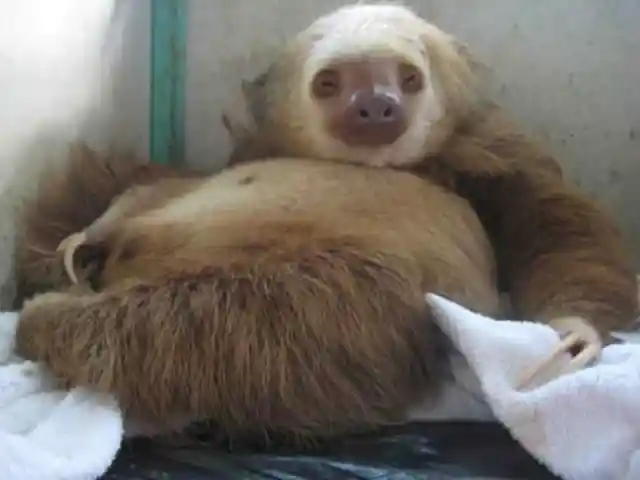
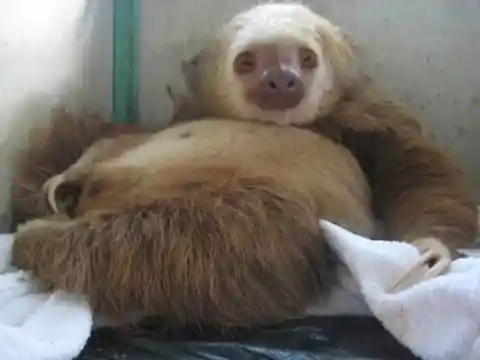
This proud pregnant momma is the slowest moving mammal on the planet. Female sloths give birth to only one newborn at a time and stay with the baby for around five months after giving birth. The gestation period of a sloth is six months for three-toed sloths and six months for two-toed sloths. Interestingly enough, due to the anatomy of the sloth it can spend up to 90% of its life hanging upside down. Their internal organs are attached to their rib cage which means that hanging upside-down doesn’t put any pressure on their lungs.
While Jaguars are not social cats, they do get pretty friendly around the mating period, which can happen anytime during a year. The mommy jaguar’s gestation period will take almost 100 days, then giving birth to up to 4 cubs. The cubs will drink milk for three months and then after six months they will gout of the den. Interestingly enough, the babies will stay with their mom for a few years while they grow more independent… While Jaguars are not social cats, they do get pretty friendly around the mating period, which can happen anytime during a year.
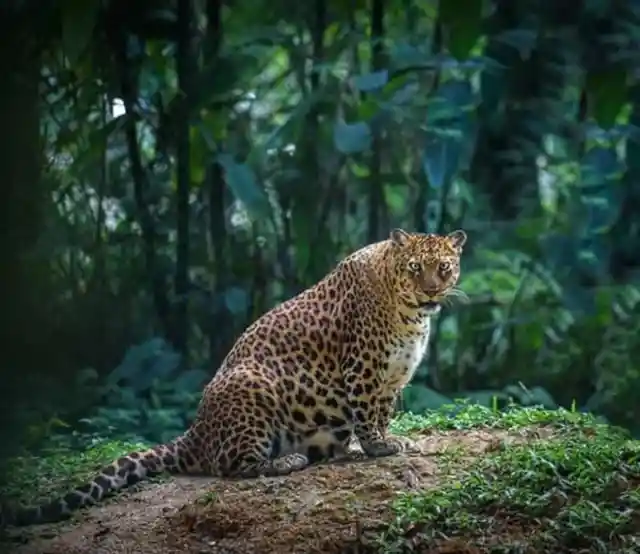

The mommy jaguar’s gestation period will take almost 100 days, then giving birth to up to 4 cubs. The cubs will drink milk for three months and then after six months they will gout of the den. Interestingly enough, the babies will stay with their mom for a few years while they grow more independent…
Sometimes when you’re pregnant you just need to lay down and take a rest. This pregnant lioness is taking a well-deserved breather from her daily routine. Lions live in groups called prides that can consist of anywhere between 4 to 37 lions. Female lions have a gestation period of about 108 days and give birth to between one to six cubs at a time. Some female cubs stay within the pride but male cubs are forced out by the age of three.


Sometimes when you’re pregnant you just need to lay down and take a rest. This pregnant lioness is taking a well-deserved breather from her daily routine. Lions live in groups called prides that can consist of anywhere between 4 to 37 lions. Female lions have a gestation period of about 108 days and give birth to between one to six cubs at a time. Some female cubs stay within the pride but male cubs are forced out by the age of three.
A female orangutan’s gestation period is close to humans’ – somewhere between 8 to 9 months. Most of the times, they only carry a baby. Female orangutans only mate after 12 years old and males 3 years later. As soon as she gives birth to her baby, she will care for it for around seven years. The first years, her baby will stay on his mom’s back, and then when it’s older, it will stay by her side.
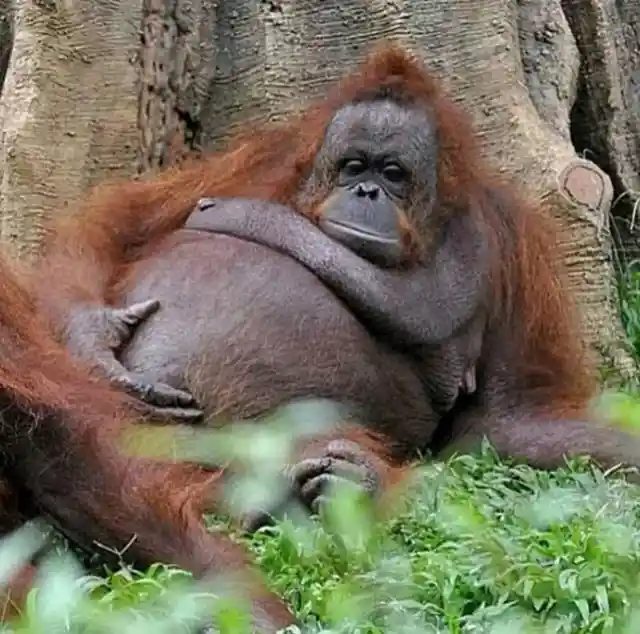
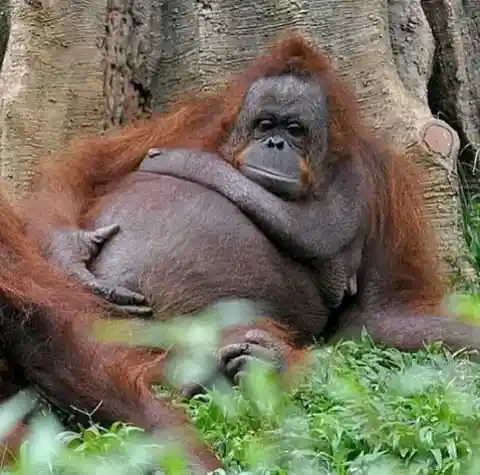
A female orangutan’s gestation period is close to humans’ – somewhere between 8 to 9 months. Most of the times, they only carry a baby. Female orangutans only mate after 12 years old and males 3 years later. As soon as she gives birth to her baby, she will care for it for around seven years. The first years, her baby will stay on his mom’s back, and then when it’s older, it will stay by her side.
Check out this chunky little momma! The groundhog mating season begins after hibernation in early March to late April. Their gestation period lasts for 31 to 32 days and give birth to litters of between 2 to 6 newborns at a time. Groundhogs are actually closely related to squirrels and are commonly referred to as ‘ground-squirrels.’ They also build intricate homes by burrowing in the ground and creating a series of tunnels. They even have dedicated rooms for going to the bathroom. The newborns stay with the mother groundhog for at least two months.


Check out this chunky little momma! The groundhog mating season begins after hibernation in early March to late April. Their gestation period lasts for 31 to 32 days and give birth to litters of between 2 to 6 newborns at a time. Groundhogs are actually closely related to squirrels and are commonly referred to as ‘ground-squirrels.’ They also build intricate homes by burrowing in the ground and creating a series of tunnels. They even have dedicated rooms for going to the bathroom. The newborns stay with the mother groundhog for at least two months.
Also known as sea cows, the manatees mate in a herd. They need one year to finish the gestation, and once they give birth to a baby, it will nurse it for 1-2 years. This is why female manatees mate once every other year. A very interesting fact is that females are sexually mature at around 5 years old, and males at nearly 10 years old!
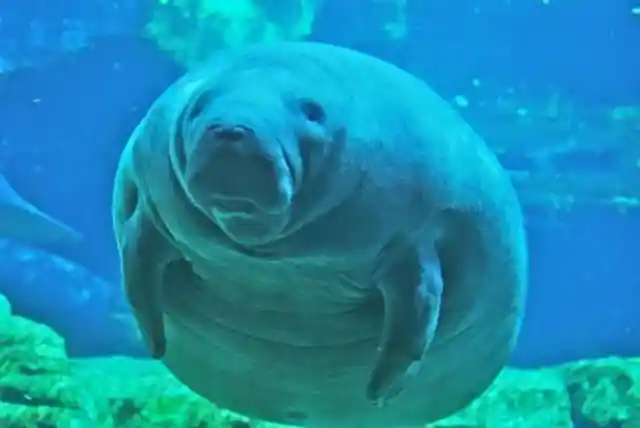

Also known as sea cows, the manatees mate in a herd. They need one year to finish the gestation, and once they give birth to a baby, it will nurse it for 1-2 years. This is why female manatees mate once every other year. A very interesting fact is that females are sexually mature at around 5 years old, and males at nearly 10 years old!
While goldfish don’t technically get pregnant, from this rather rotund display, it certainly looks like they do. This goldfish is full of eggs ready to be lain and fertilized. When water temperatures rise, female goldfish will release hundreds, sometimes thousands of eggs. Like most fish, goldfish do not care for their young. Quite the opposite, adult goldfish will commonly eat the young when possible. Yikes! The newly hatched goldfish are referred to as ‘fry’ and they survive on a diet of brine shrimp and daphnia. Talk about a difficult childhood… While goldfish don’t technically get pregnant, from this rather rotund display, it certainly looks like they do.
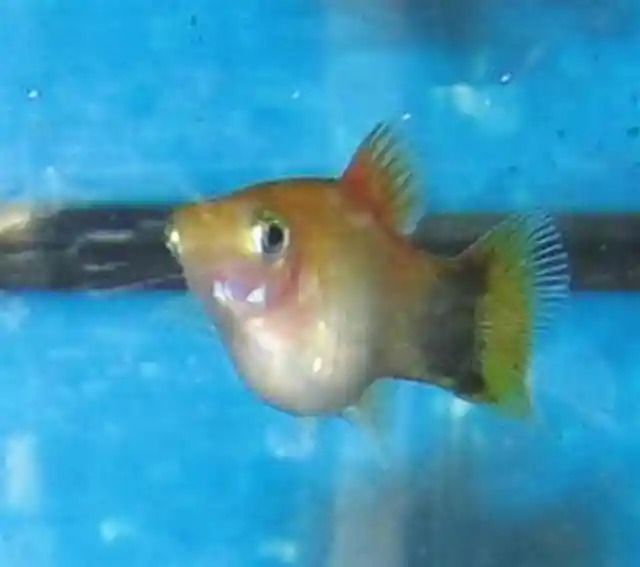
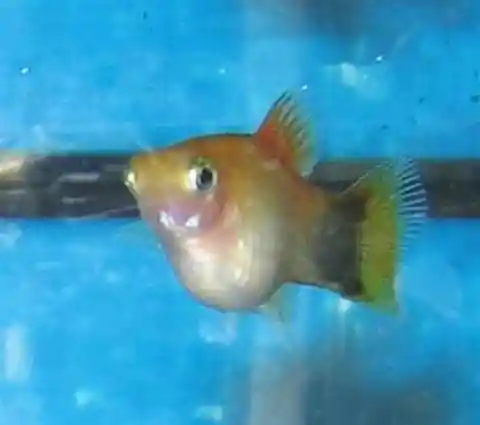
This goldfish is full of eggs ready to be lain and fertilized. When water temperatures rise, female goldfish will release hundreds, sometimes thousands of eggs. Like most fish, goldfish do not care for their young. Quite the opposite, adult goldfish will commonly eat the young when possible. Yikes! The newly hatched goldfish are referred to as ‘fry’ and they survive on a diet of brine shrimp and daphnia. Talk about a difficult childhood…
A zebra’s gestation period is 12-13 months, and when she gives birth, she only has a foal – rarely, they give birth to twins. If it’s a male foal, it will stay with the herd for only 18 months and then he will have to look for a different herd or form one of his own. If it’s a female, she will stay with the herd which is made of one male and more females.
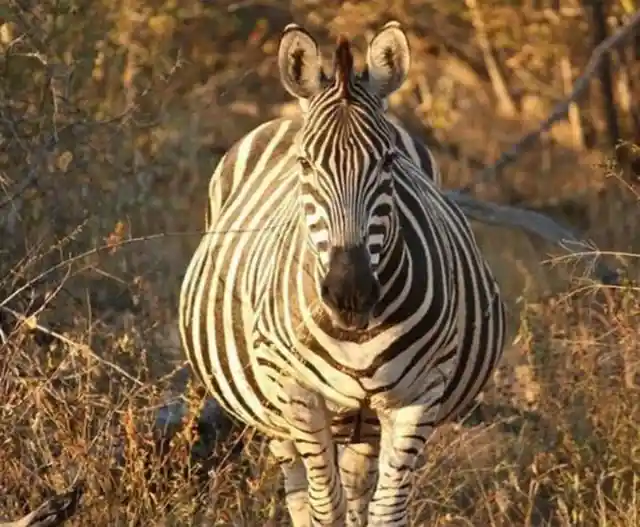
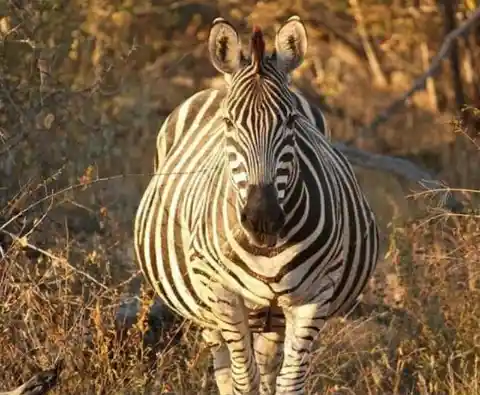
A zebra’s gestation period is 12-13 months, and when she gives birth, she only has a foal – rarely, they give birth to twins. If it’s a male foal, it will stay with the herd for only 18 months and then he will have to look for a different herd or form one of his own. If it’s a female, she will stay with the herd which is made of one male and more females.
Most baby hedgehogs, known as hoglets, are born during the summer months of June and July. The average gestation period for a pregnant hedgehog is around four and a half weeks long and they give birth to litters of four of five little hoglets. The newborn hoglets feed off their mother’s milk for the first three to four weeks of their lives then start venturing outside of their nests. After learning how to forage for food with their mother, the hoglets will wander off on their own.
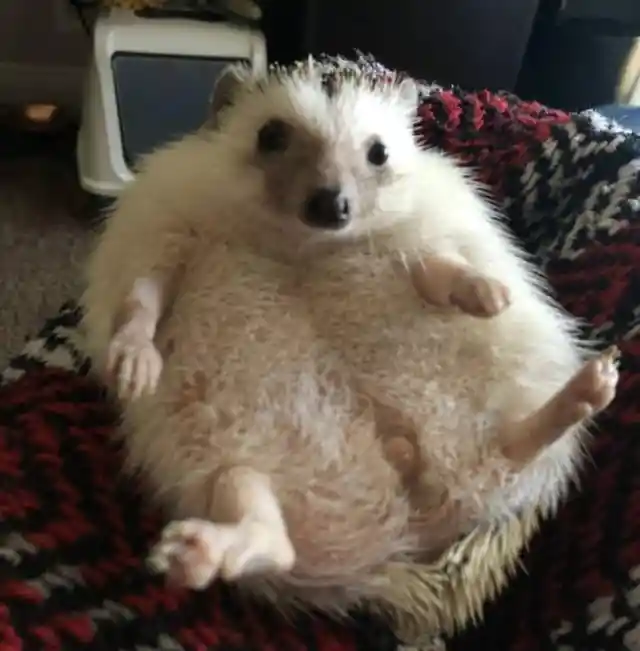
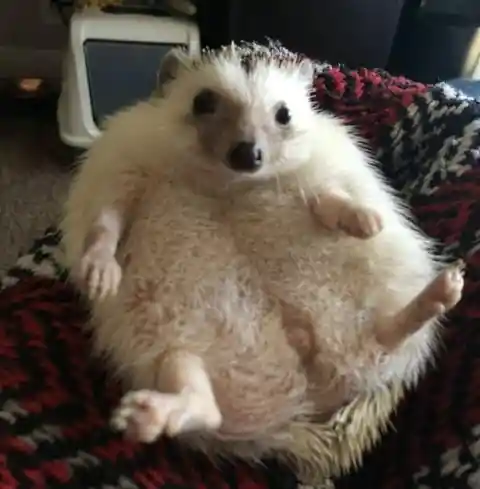
Most baby hedgehogs, known as hoglets, are born during the summer months of June and July. The average gestation period for a pregnant hedgehog is around four and a half weeks long and they give birth to litters of four of five little hoglets. The newborn hoglets feed off their mother’s milk for the first three to four weeks of their lives then start venturing outside of their nests. After learning how to forage for food with their mother, the hoglets will wander off on their own.
A squirrel can have two litters in one year, but it only depends on the food she has around her. If the food is scarce, she will only have a litter per year. After 44 days of gestation, she can give birth to nearly four babies, also called kittens! They’re born blind and with no hair, but at 10 weeks old they are weened and ready to explore the world.


A squirrel can have two litters in one year, but it only depends on the food she has around her. If the food is scarce, she will only have a litter per year. After 44 days of gestation, she can give birth to nearly four babies, also called kittens! They’re born blind and with no hair, but at 10 weeks old they are weened and ready to explore the world.
We’ve all heard of the saying “to breed like rabbits,” and well… it’s pretty much based in truth. Rabbits have a shockingly short gestation period of only 30 days and give birth to anywhere between 4 to 12 kits at a time. Rabbit breeding season lasts three-quarters of the year and rabbit are able to get pregnant almost immediately after giving birth. So that’s to say that rabbits could theoretically give birth to 100 babies per season, and over a lifetime 1,000 babies.


We’ve all heard of the saying “to breed like rabbits,” and well… it’s pretty much based in truth. Rabbits have a shockingly short gestation period of only 30 days and give birth to anywhere between 4 to 12 kits at a time. Rabbit breeding season lasts three-quarters of the year and rabbit are able to get pregnant almost immediately after giving birth. So that’s to say that rabbits could theoretically give birth to 100 babies per season, and over a lifetime 1,000 babies.
This pregnant and fat mommy has to wait around 16 weeks to give birth to nearly 3 cubs at a time. The babies are blind and need a lot of care and attention from their mom in the first months.
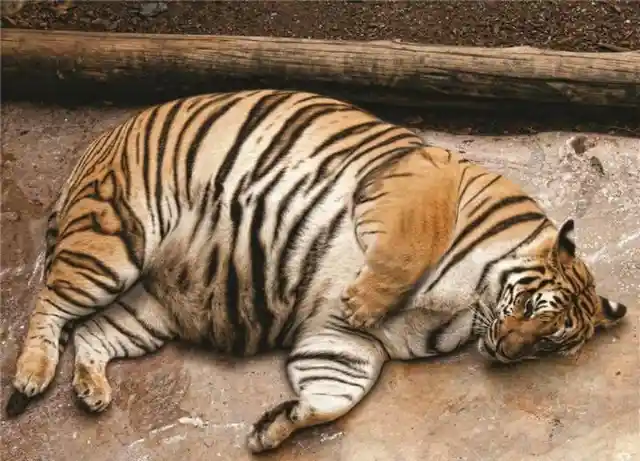
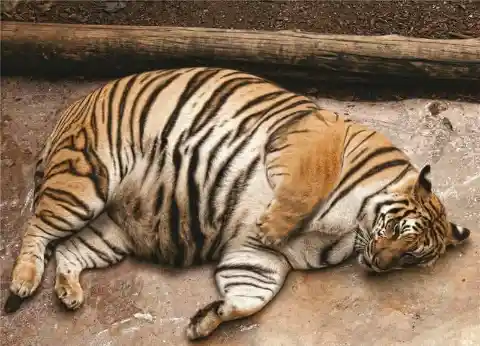
This pregnant and fat mommy has to wait around 16 weeks to give birth to nearly 3 cubs at a time. The babies are blind and need a lot of care and attention from their mom in the first months.
This pregnant cat is enjoying a luxurious sprawl in the sun and giving her slender legs a well-deserved rest from all the extra weight she has put on and carried around. The gestation period for a cat is about 2 months. The average litter for a cat is around 4 kittens and a female cat can sire offspring from multiple male cats. Meaning, a cat can give birth to up to 5 kittens from 5 different fathers. The kittens are eventually weaned from their mother between 8 to 10 weeks old.


This pregnant cat is enjoying a luxurious sprawl in the sun and giving her slender legs a well-deserved rest from all the extra weight she has put on and carried around. The gestation period for a cat is about 2 months. The average litter for a cat is around 4 kittens and a female cat can sire offspring from multiple male cats. Meaning, a cat can give birth to up to 5 kittens from 5 different fathers. The kittens are eventually weaned from their mother between 8 to 10 weeks old.
Dogs are sexually mature somewhere around 6 to 12 months, but it all depends on the breed – some need two years to reach sexual maturity. A dog has a 63 day-long gestation and can give birth to 3-15 puppies at a time. The larger the breed, the bigger the litter!


Dogs are sexually mature somewhere around 6 to 12 months, but it all depends on the breed – some need two years to reach sexual maturity. A dog has a 63 day-long gestation and can give birth to 3-15 puppies at a time. The larger the breed, the bigger the litter!
This pregnant goat is ready to have kids. Did you know that baby goats are called kids just like humans? Female goats reach maturity around 15 months old and are then capable of having kids. Breeders, however, generally wait until the female goat has reached 70% of her adult weight. The gestation period for a goat is on average 150 days and goats most commonly have twins, but single births and triplets are also possible. Goats are known for their willingness to eat just about anything, including tin cans and cardboard boxes.
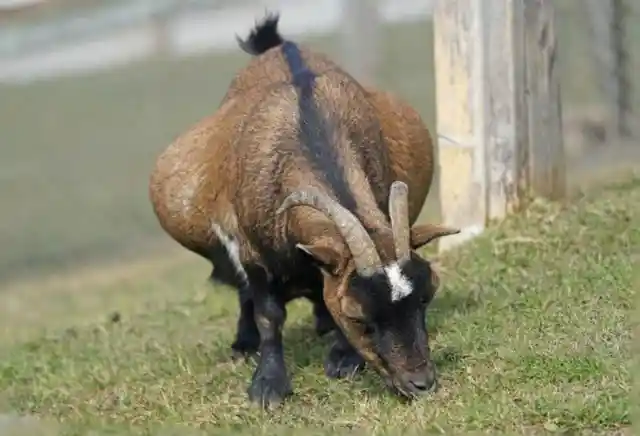
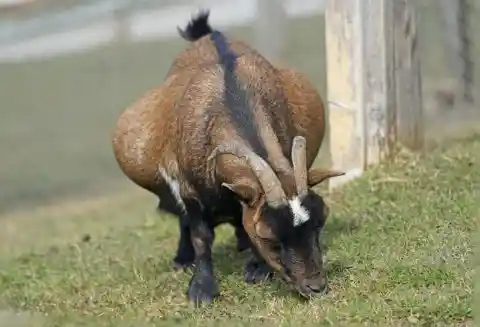
This pregnant goat is ready to have kids. Did you know that baby goats are called kids just like humans? Female goats reach maturity around 15 months old and are then capable of having kids. Breeders, however, generally wait until the female goat has reached 70% of her adult weight. The gestation period for a goat is on average 150 days and goats most commonly have twins, but single births and triplets are also possible. Goats are known for their willingness to eat just about anything, including tin cans and cardboard boxes.
This is a rather interesting frog because it was genetically modified over 10 years ago for some studies. That’s why it’s transparent! You can see the frog’s eggs that are ready to be laid for fertilization.
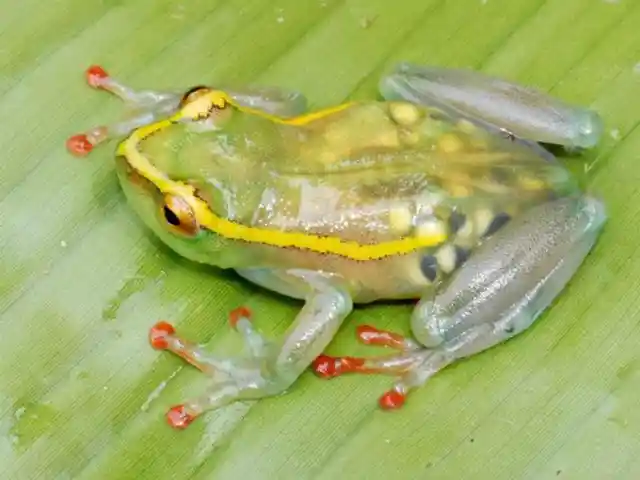
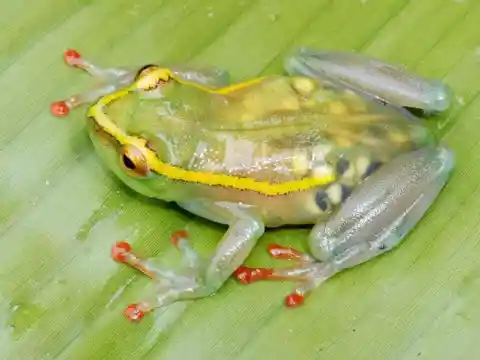
This is a rather interesting frog because it was genetically modified over 10 years ago for some studies. That’s why it’s transparent! You can see the frog’s eggs that are ready to be laid for fertilization.
Once Meerkats reach the age of 1, they are sexually mature. A female will have a period of gestation for nearly 11 months, giving birth to 3 pups at a time. She will wean them two months later, so she could finally go hunt. The mother will leave her babies with a babysitter from her “gang”!
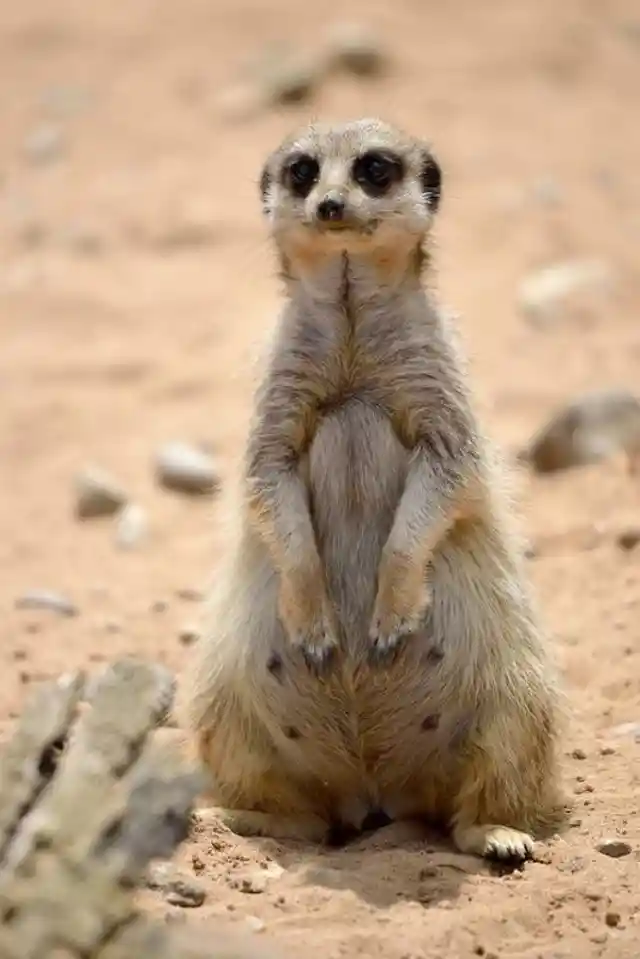

Once Meerkats reach the age of 1, they are sexually mature. A female will have a period of gestation for nearly 11 months, giving birth to 3 pups at a time. She will wean them two months later, so she could finally go hunt. The mother will leave her babies with a babysitter from her “gang”!
The average lifespan of the common brown rat is only one year, but they compensate for that in the shockingly massive amount of reproduction that they are capable of. The gestation period of rats is just 21 to 23 days long. Each litter can produce anywhere from 5 to 10 baby rats. Amazingly a pair of rats can produce as many as 1,250 offspring in a given year. Not to fear though, things like a lack of food and shelter, disease, predators, pest control, in-fighting and cannibalism all keep their numbers in check.
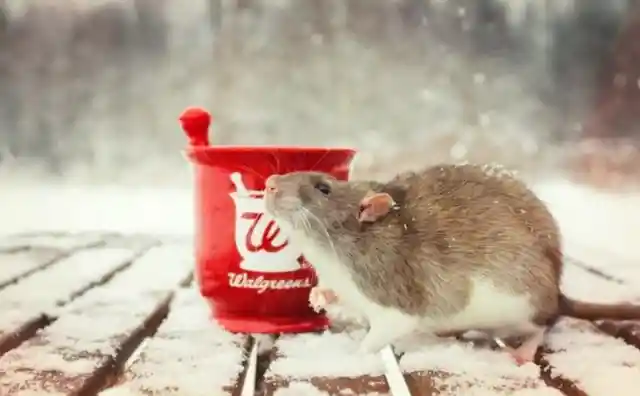
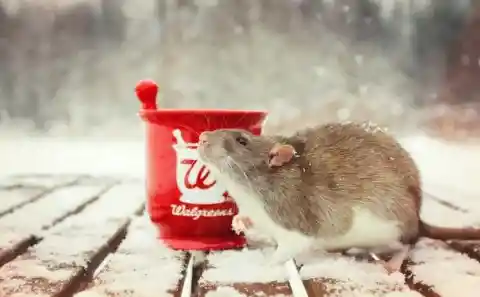
The average lifespan of the common brown rat is only one year, but they compensate for that in the shockingly massive amount of reproduction that they are capable of. The gestation period of rats is just 21 to 23 days long. Each litter can produce anywhere from 5 to 10 baby rats. Amazingly a pair of rats can produce as many as 1,250 offspring in a given year. Not to fear though, things like a lack of food and shelter, disease, predators, pest control, in-fighting and cannibalism all keep their numbers in check.
After reaching the age of 14, female elephants will start breeding. But that’s not quite fun, because it takes 22 months to finally give birth to a calf! The females from the herd will care for the baby elephant when the mom goes to eat to produce milk – her baby will need around 10 gallons of milk per day to grow up healthy!
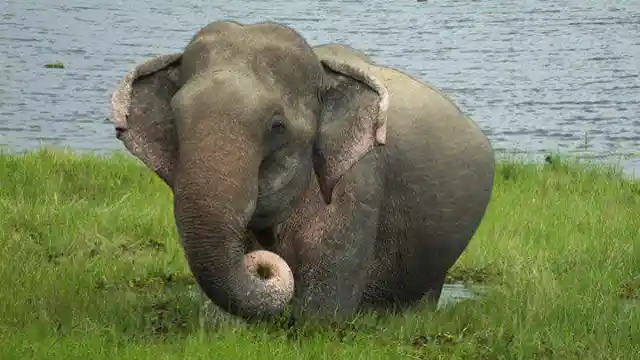

After reaching the age of 14, female elephants will start breeding. But that’s not quite fun, because it takes 22 months to finally give birth to a calf! The females from the herd will care for the baby elephant when the mom goes to eat to produce milk – her baby will need around 10 gallons of milk per day to grow up healthy!
The gestation period of a pony is 11 months long and ponies generally give birth to only one offspring at a time. Twins are possible but are quite rare. Just an hour after birth a newborn foal is able to stand. Foals are weaned from their mothers at around 4 to 5 months old. After being weaned off their mother they eat a diet consisting of grain and hay. Ponies, like other types of horses, are able to sleep while standing up.
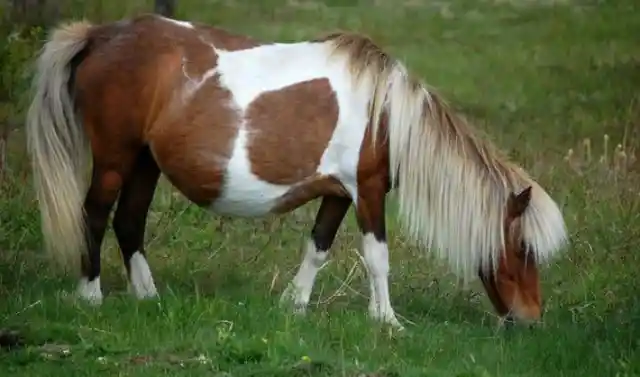
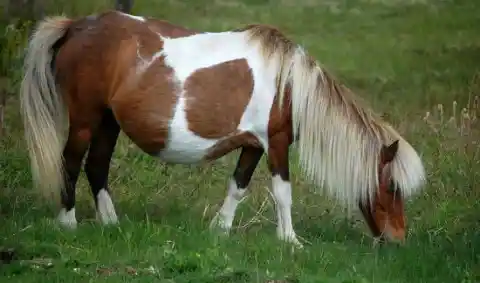
The gestation period of a pony is 11 months long and ponies generally give birth to only one offspring at a time. Twins are possible but are quite rare. Just an hour after birth a newborn foal is able to stand. Foals are weaned from their mothers at around 4 to 5 months old. After being weaned off their mother they eat a diet consisting of grain and hay. Ponies, like other types of horses, are able to sleep while standing up.
Finally, this mommy cannot wait to finally give birth to her calf, considering gestation is 14-15 months! That's why they usually give birth to one calf, once every two or three years. For the first year, beluga calves will need to be nursed by their moms until their teeth emerge and then they can fianlly eat shrimps or small fish.
Finally, this mommy cannot wait to finally give birth to her calf, considering gestation is 14-15 months!


That's why they usually give birth to one calf, once every two or three years. For the first year, beluga calves will need to be nursed by their moms until their teeth emerge and then they can fianlly eat shrimps or small fish.